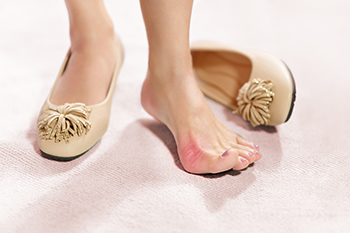
A bump on the side of the big toe may be classified as a bunion. It can be large or small depending on how fast it develops. It may be uncomfortable and can happen as a result of wearing shoes that do not have adequate room for the toes to move around in. Some patients have pain in the bottom of their big toe that may gradually develop into the rest of the foot. In severe cases, the bunion may cause the other toes to shift and can result in overlapping. Many patients choose to have an X-ray taken and this can be beneficial in determining the extent of the deformity, in addition to observing if there is wear and tear on the joint. This condition may be the result of an abnormal foot structure and may happen to people who have flat feet. Additional reasons why people may develop a bunion can be from having endured a foot injury or possibly from collagen deficiency diseases. If you have a bunion, please confer with a podiatrist who can recommend what type of treatment is correct for you, and how to find permanent relief.
If you are suffering from bunion pain, contact one of our podiatrists of Lansing Podiatry. Our doctor can provide the care you need to keep you pain-free and on your feet.
What Is a Bunion?
Bunions are painful bony bumps that usually develop on the inside of the foot at the joint of the big toe. As the deformity increases over time, it may become painful to walk and wear shoes. Women are more likely to exacerbate existing bunions since they often wear tight, narrow shoes that shift their toes together. Bunion pain can be relieved by wearing wider shoes with enough room for the toes.
Causes
- Genetics – some people inherit feet that are more prone to bunion development
- Inflammatory Conditions - rheumatoid arthritis and polio may cause bunion development
Symptoms
- Redness and inflammation
- Pain and tenderness
- Callus or corns on the bump
- Restricted motion in the big toe
In order to diagnose your bunion, your podiatrist may ask about your medical history, symptoms, and general health. Your doctor might also order an x-ray to take a closer look at your feet. Nonsurgical treatment options include orthotics, padding, icing, changes in footwear, and medication. If nonsurgical treatments don’t alleviate your bunion pain, surgery may be necessary.
If you have any questions, please feel free to contact our office located in East Lansing, MI . We offer the newest diagnostic and treatment technologies for all your foot care needs.
